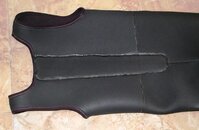soon2bff
Registered
I'm really trying to get some base knowledge before going to shops some more. I went to one that broke down some info really well for me. I was impressed and it made me even more excited about this!
I'm going to be diving in SoCal, San Diego area more specifically. Cold water...got it.
I know the answer is "what fits you best". Pretty good disclaimer, huh? I see 5mm and 7mm as the necessity. I'm tall, 6'7", and athletic built, 265 lbs. Are they relatively the same? Im sure there's more than one that fits me, and I dont assume I'll be able to test many before buying. If the wetsuits fit me and they're the same thickness, will there be a significant difference in the warmth/protection?
I'm going to be diving in SoCal, San Diego area more specifically. Cold water...got it.
I know the answer is "what fits you best". Pretty good disclaimer, huh? I see 5mm and 7mm as the necessity. I'm tall, 6'7", and athletic built, 265 lbs. Are they relatively the same? Im sure there's more than one that fits me, and I dont assume I'll be able to test many before buying. If the wetsuits fit me and they're the same thickness, will there be a significant difference in the warmth/protection?




